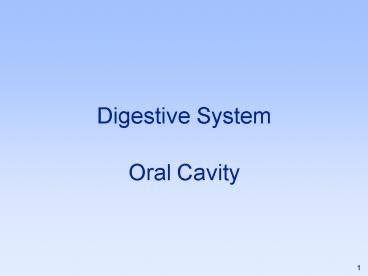Digestive System PowerPoint PPT Presentation
1 / 35
Title: Digestive System
1
Digestive System
- Oral Cavity
2
(No Transcript)
3
Oral Cavity
- Formed by
- - cheeks
- - lips (labia)
- - hard palate
- - soft palate
- - tongue
4
Oral Cavity (cont.)
- vestibule - space bounded externally by cheeks
and lips, and internally by gums and teeth - oral cavity proper - space that extends from gums
and teeth to fauces - fauces - (opening) between oral cavity and the
pharynx
5
Cheeks
- form lateral walls
- muscular structures covered by skin on the
outside - lined on inside by nonkertanized stratified
squamous epithelium
6
Lips (labia)
- fleshy folds of skin surrounding the orifice
(opening) of the mouth - vermilion border - transitional zone of lips
where external skin meets internal mucous
membrane - inner surface of lips are connected to gingiva
(gum tissue) by mucous membrane called the frenum
7
(No Transcript)
8
Hard Palate
- anterior portion of roof of mouth
- formed by maxillary and palatine bones
- covered by mucous membrane
- forms partition between oral and nasal cavities
9
Soft Palate
- forms posterior portion of roof of mouth
- lacks bony quality of hard palate
- arch-shaped muscular partition
- between oropharynx and nasopharynx
- lined with mucous membrane
- uvula - muscular process that hangs from free
border of soft palate - posterior border opens into oropharynx through
fauces
10
Palatopharyngeal Arch
- anterior muscular fold on either side of base of
uvula - runs down lateral side of soft palate
- extends to side and base of tongue
- Palatoglossal Arch
- posterior muscular fold on either side of base of
uvula - extends to side of pharynx
11
Tonsils
- masses of lymphatic tissue
- Three types
- - palatine
- - lingual
- - pharyngeal (adenoids)
12
Tongue
- forms floor of oral cavity
- composed of skeletal muscle fibers running in
several directions - covered with mucous membrane
- connected in midline to floor of oral cavity by
lingual frenum - papillae are located on the tongue which aid in
the manipulation of food
13
(No Transcript)
14
Muscular Fibers of Tongue
- extrinsic muscles
- - originate outside tongue
- - insert into tongue
- - maneuver and move food
- intrinsic muscles
- - originate and insert within tongue
- - alter shape and size of tongue
15
Tongue Papillae
- filiform
- - thickly distributed over anterior two-thirds
of dorsum of tongue - fungiform
- - scattered irregularly on dorsum of tongue
- circumvallate
- - 8-12 papillae
- - form V-shape in posterior of tongue
16
Taste Buds
- located in and around papillae on tongue
- Four Primary Tastes
- - sweet - lateral border in anterior
- - sour - anterior 1/2 to midline
- - salty - lateral borders in anterior
- - bitter - bitter
17
Salivary Glands
- parotid
- - located anterior and inferior to ears
- - largest
- submandibular
- - located beneath the base of tongue
- sublingual
- - located in the floor of mouth
- - smallest
18
(No Transcript)
19
Salivary Secretions
- Two types of cells
- - serous cells produce a watery fluid that
contains a digestive enzyme called amylase - - mucous cells secrete thick mucus that binds
particles together and lubricates during
swallowing - pH of saliva is 6.35 to 6.85
20
Teeth
- aid in mastication
- mechanically break food into smaller pieces
- helps to mix food with saliva
- Two sets of teeth
- - deciduous (begin erupting by 6 months old
begin exfoliating by 6 years old) - - permanent (begin erupting by 6 years old)
21
(No Transcript)
22
Types of Teeth
- Primary Permanent
- incisors 8 8
- cuspids 4
4 - premolars 8
- molars 8
12 - 20
32
23
(No Transcript)
24
Incisors
- two pairs in each jaw
- one central, one lateral
- chisel-shaped
- one root
- cuts food
25
Cuspids
- also known as canines
- one pair in each jaw
- one cusp or pointed surface
- used to tear or shred food
26
Premolars
- also known as bicuspids
- two pairs in each jaw
- first and second premolar
- two cusps and one root (maxillary first premolars
have two roots) - used to crush and grind food
27
Molars
- three pairs in each jaw
- first, second, and third molars
- flattened crowns
- prominent ridges
- three roots
- used to crush and grind food
28
Anatomy of a Tooth
- crown
- - exposed portion above level of gingiva
- - contains the pulp cavity
- neck
- - narrow junction between crown and roots
- root
- - embedded in alveolar bone
- - contains root canals - nerves, blood and
lymphatic vessels
29
(No Transcript)
30
Composition of a Tooth
- dentin
- enamel
- pulp
- cementum
- periodontal ligament
31
Dentin
- dense, hard, light yellow substance
- makes up bulk of tooth
- calcified connective tissue
- harder than bone, but softer than enamel
- gives the tooth its basic shape and rigidity
- encloses pulp cavity
32
Enamel
- hardest tissue in the human body
- consists of primarily calcium phosphate and
calcium - hard tissue that covers the entire crown of the
tooth - protects the dentin
33
Pulp
- connective tissue containing blood and lymphatic
vessels, and nerves - fills pulp cavity and root canals
34
Cementum
- bone-like
- covers roots of teeth in a thin layer
- joins enamel near cervix of tooth
35
Periodontal Ligament
- group of connective fibers
- suspends the tooth in the socket
- absorbs shock of mastication
- supports gingiva

